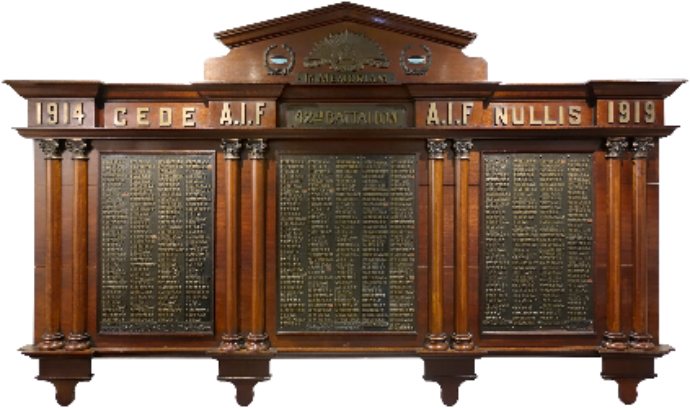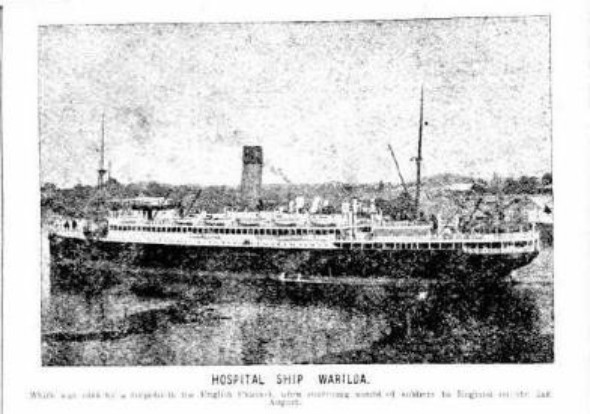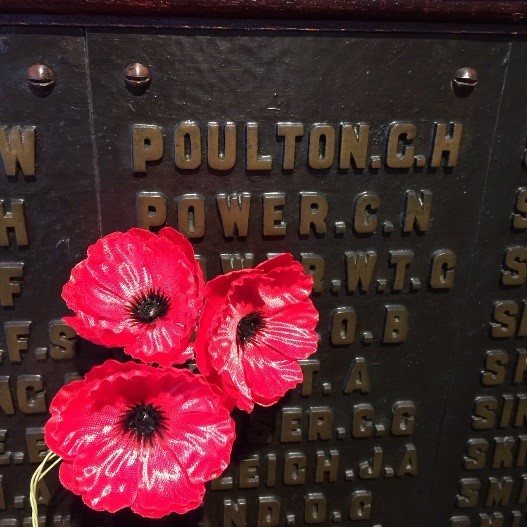The Tragedy of the HMAT Warilda: Charles Norman Power
By Alice Rawkins, Visitor Services Assistant, Anzac Square | 11 November 2020
On 3 August 1918 the HMAT Warilda, an Australian hospital ship, was struck and sunk by a torpedo from a German U-boat. The vessel had been transporting sick and wounded Allied soldiers across the English Channel and was clearly marked with a Red Cross. At the time of the attack there were 801 people aboard. Sadly, 123 lost their lives, including Australian soldier Charles Norman Power. His story was discovered during a project at Anzac Square to link the names on the 42nd Infantry Honour Board with soldier portraits in the State library of Queensland’s online catalogue, One Search. While staff have been unable to locate a photo of Charles, his service records reveals a remarkable tale of illness, injury, misfortune and coincidence.

42 Infantry Battalion Honour Board, World War One Crypt, Anzac Square Brisbane
On 1 August 1915 Charles Norman Power enlisted in the Australian Imperial Forces. He was 21 years old and had previously been working as a butcher. He was initially assigned to Reinforcements for the 15th Infantry Battalion, which had been severely reduced due to ongoing fighting at Gallipoli. On 10 October 1915 Charles embarked on the HMAT Warilda bound for Egypt. This would be the very same ship he would die aboard three years later.
In Egypt, Charles was transferred to the 47th Battalion, which was formed as part of the expansion of the AIF following the disastrous Gallipoli Campaign. While stationed in the Middle East he was treated for mumps and gastroenteritis, common illnesses among soldiers due to unhealthy and cramped living conditions. In early June 1916 Charles and his unit embarked aboard the HMT Caledonia bound for Marseilles, France.
The 47th Battalion arrived on the Western Front on 9 June 1916 and entered the frontline on 3 July. Their first major action was during the Battle of Pozieres. The battalion endured two stints in these heavily contested trenches and suffered high casualty rates. It was here, at the end of July, that Charles contracted scabies, an infestation of mites, which results in relentless itchiness and red angry rashes. After recovering from scabies, he contracted trench fever in early September. Trench fever was transmitted by lice and symptoms included fevers, headaches and muscles pains. Following treatment and rest he returned to duty on 31 October 1916.
On the 22 November 1916, less than a month after returning to his battalion from illness, Charles was wounded in action for the first time, receiving a gunshot wound to the abdomen. At the time he was also suffering from ICT Arm (inflammation of the connective tissue) and radiculitis herpes of the mouth. He was transferred to England for treatment, again travelling aboard the HMAT Warilda, which had recently been converted to a hospital ship. In England he was admitted to the 1st Southern General Hospital and the Holborn Military Hospital before returning to active service in early 1917.

The Week, Brisbane, Friday 16 August 1916, page 12
In 1917 Charles was moved between several battalions including the 69th Battalion and 12th Australian Light Trench Mortar Battery. He was also charged three times for being absent without leave (AWL), resulting in an accumulated 56 days in detention and 150 days without pay. On one occasion he was AWL for 39 days before handing himself in to military police.
In November 1917, Charles returned to the 47th Battalion, which was stationed in Belgium and assisting with fighting at Passchendaele. In early 1918 the 47th was moved to France to help turn back the German advance during the Spring Offensive. They were heavily involved in action that took place around Dernancourt. It was during this fighting on 27 March that Charles was wounded in action for a second time, receiving a gunshot wound in the side and shrapnel wounds on his arms. He was transferred back to England for treatment and furlough before being reassigned to the 42nd Battalion and returning to the frontline again in June. He served with this battalion in France for less than a month before he was admitted to the 20th Casualty Clearing Station on 27 July with D.A.H (Disorderly Action of the Heart). This disorder was also known as ‘Soldier’s Heart’ and was caused from stress and fatigue.
On 1 August 1918 Charles Norman Power embarked on the HMAT Warilda one last time. He was bound for treatment in England to addresses his heart issues. However, tragedy struck at 1:35am on 3 August when a torpedo was fired from a German U-Boat UC-49, striking the Warilda’s starboard propeller. The attack caused the engine room to flood and damaged the steering gear and the ship moved in a circle at about 15 knots, preventing lifeboats being lowered. The HMS P.39, an escort ship, attempted to tow the Warilda, but the line had to be cut when it became clear that she was going to sink, which she finally did at 4:10 am. Following this event Charles was reported as “missing, believed drowned at sea”. Private J. Fisherman gave evidence during an investigation, explaining that he had gone aboard the Warilda with Charles, but they had been placed in different wards. He recalled that:
“After the explosion we were all placed on destroyers. When we
landed at Southampton all the Australians were placed together in
one square, I searched thoroughly but could find no trace of Power.”
Charles was one of 15 Australians who drowned when the Warilda sunk. His service records give an insight into the grim reality of fighting in the First World War. He was plagued by illness and injury, was shuffled between numerous battalions and fought in some of the most heavily contested areas. He died just four months before the end of the war aboard the very same ship that had transported him overseas at the beginning of his service in 1915.

42 Infantry Battalion Honour Board, World War One Crypt, Anzac Square Brisbane
Visit the Anzac Square Memorial Galleries to learn more about the men and women, like Charles, who bravely served in the First World War. The galleries are open 10-4 Sunday to Friday.
Additional Resources:
- Charles Norman Power: Service Records
- Charles Norman Power: Australian Red Cross Society Wounded and Missing Enquiry Bureau Files
- Newspaper Article: Torpedoed Warilda
- Newspaper Article: Family Notices
- 42 Infantry Battalion Honour Board: Soldier Portrait Tag list
- Anzac Square: Website
More information
Membership - https://patron.slq.qld.gov.au/Register
Comments
Your email address will not be published.
We welcome relevant, respectful comments.